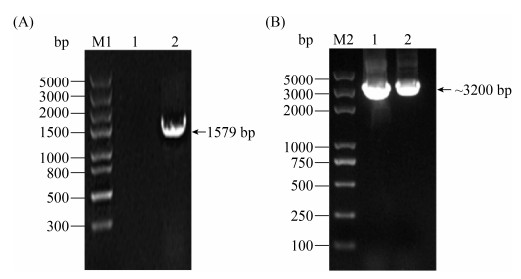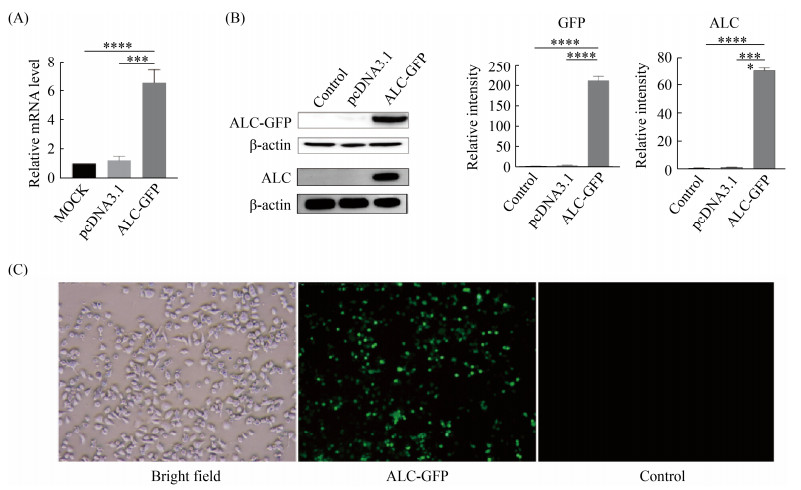中国科学院微生物研究所,中国微生物学会,中国菌物学会
文章信息
- 高洁, 王建新, 南楠, 宫赛赛, 李涛, 王慧. 2021
- Jie Gao, Jianxin Wang, Nan Nan, Saisai Gong, Tao Li, Hui Wang. 2021
- A型肉毒毒素轻链胞内持留模型的建立
- Establishment of an intracellular persistence model of botulinum toxin type A light chain
- 微生物学报, 61(11): 3496-3505
- Acta Microbiologica Sinica, 61(11): 3496-3505
-
文章历史
- 收稿日期:2021-01-24
- 修回日期:2021-03-20
- 网络出版日期:2021-03-30
肉毒毒素(botulinum toxins,BoNTs)作为一类细菌蛋白外毒素[1],是由50 kDa的轻链(light chain,LC)和100 kDa的重链(heavy chain,HC)组成的150 kDa的生物大分子,轻链和重链间由二硫键连接[2]。结构上,完整的成熟毒素包括3个结构域:N端轻链Zn2+金属蛋白酶活性结构域,重链N端50 kDa跨膜转运结构域,以及重链C端50 kDa受体结合域[3-4]。导致肉毒中毒的方式具有多样性,其中食物中毒最为常见,除此之外,也可能发生创伤性肉毒中毒、婴儿肉毒中毒或其他原因不明的肉毒中毒[5]。肉毒毒素毒性强[6],成人致死剂量只有ng/kg[7],且易于生产,被美国CDC认为是潜在的生物武器。
肉毒毒素分为A-H八种血清型[8-9],其中A、B、E、F型能导致人类致病[10]。肉毒毒素引起的中毒都是通过将LC蛋白传递到细胞质中,在细胞质中特异性地切割3种可溶性NSF附着蛋白受体(soluble N-ethylmaleimide sensitive factor attachment protein receptor,SNARE)蛋白来毒害神经元的[1-13],其中A、E型肉毒毒素切割SNARE蛋白中的突触小体相关蛋白-25 (Synaptosome- associated protein of 25 kDa,SNAP-25),B、D、F、G型肉毒毒素裂解突触小泡缔合型蛋白(Vesicle-associated membrane protein/synaptobrevin,VAMP),C型肉毒毒素会同时切割SNAP25和突出融合蛋白(syntaxin,Stx)。这些不同血清型的毒素在在中毒患者体内表现出不同的效力和持久性[14],到目前为止在人类和啮齿动物中的现有数据一致证明A型肉毒毒素引起的中毒持续时间最长[15-18]。A型肉毒毒素在体内长期持留会引起机体机能的长时间破坏,严重影响到机体的正常活动,危害身体健康,也是A毒治疗困难的重要原因。所以,建立A型肉毒毒素的持留模型,对于研究肉毒毒素在体内长久持留的原因,寻找肉毒毒素的有效解毒药物具有重要意义。
到目前为止,国内外研究工作者对于探究肉毒毒素的胞内持留的防治开展了大量的工作[19-25],但是由于肉毒毒素毒性极强和现有的检测方法的灵敏度达不到检测毒素在体水平,所以无法建立合适的动物模型用于胞内的持留研究。其次由于肉毒毒素抗体种类较少,且价格较贵,也不适于在细胞水平上大规模直接检测天然毒素的持留情况,这也限制了毒素进入细胞后的实时持留过程的直接观察。有研究报道利用荧光标记生物分子,通过荧光效果来进行生物分子在细胞内的示踪,并取得了突破性成果[26-34],为我们的研究提供了启发。
在这项研究中,我们通过将A型肉毒毒素轻链ALC与绿色荧光蛋白基因(Green Fluorescent Protein,GFP)连接,并构建到质粒pcDNA3.1上,并将质粒pcDNA3.1-ALC-GFP其转染进毒素靶细胞Nureo-2a细胞中,模拟A型肉毒毒素在体内的中毒,通过检测ALC-GFP表达后不同时间时神经细胞内ALC-GFP蛋白含量变化,及底物蛋白SNAP-25的切割情况,建立了一种简易便捷的观测模型。此外,我们利用该模型筛选了潜在的抗肉毒化合物,成功的筛选到潜在的抗肉毒药物CB3,为研究A型肉毒素素引起长期中毒的机制,寻找相应的解毒方法奠定了基础。
1 材料和方法 1.1 材料 1.1.1 细胞:Nureo-2a细胞为本室保存。
1.1.2 主要试剂:DMEM培养基购自Gibco公司;GFP抗体、SNAP-25抗体购自CST公司;ALC抗体购买自RD-SYSTEMS公司;β-Actin抗体、羊抗兔二抗、羊抗鼠二抗购自TransGen公司;无内毒素质粒提取试剂盒、RNA提取试剂盒、RT-PCR试剂盒购自TIANGEN公司;LipofectamineⓇ2000购自Invitrogen公司;Cycloheximide抑制剂购自MCE公司;高效RIPA组织/细胞裂解液购自Solarbio公司。
1.1.3 主要仪器:PCR仪购自Thermo scientifc公司;细胞培养箱购自太仓市实验仪器厂;倒置荧光显微镜购自Olympus公司;凝胶图像分析仪购自Bio-Rad公司;全自动酶联免疫检测仪购自BioTek Gen5公司;LightCyclerⓇ 96荧光定量PCR仪购自Roche公司。
1.2 构建与鉴定pcDNA3.1-ALC-GFP重组质粒将GFP连接在ALC的N端,并插入到pcDNA3.1的Hin1 II和BamH I位点,设计pcDNA3.1-ALC-GFP重组质粒并送往北京天一辉远生物科技有限公司构建。收到构建好的菌株后,对重组质粒菌株进行PCR验证。PCR引物序列为pEGFP-NF:5′-TgggAggTCTATATAAgCAg Ag-3′,pEGFP-NR:5′-CgTCgCCgTCCAgCTCgAC CAg-3′,由北京天一辉远生物科技有限公司合成。PCR扩增体系为:菌液模板1 μL,上下游引物0.5 μL,Dream Taq Green PCR Master Mix (2×) 15 μL,去离子水13 μL。扩增条件为:94 ℃ 5 min;94 ℃ 30 s,55 ℃ 90 s,72 ℃ 30 s,35个循环;72 ℃ 10 min。进行1%琼脂糖凝胶电泳,在紫外灯下检测PCR扩增产物。
1.3 无内毒素质粒提取将构建好的菌株接种到氨苄抗性的LB培养基中培养,利用无内毒素质粒提取试剂盒提取pcDNA3.1-ALC-GFP重组质粒,然后进行1%琼脂糖凝胶电泳,在紫外灯下检测质粒提取效果,利用全自动酶联免疫检测仪在280 nm处测定重组质粒纯度与浓度。
1.4 ALC-GFP胞内表达水平的检测用胰酶消化传代培养的Nureo-2a细胞,进行细胞计数,并接种于12孔板中,在不含抗生素的完全培养基(10% FBS牛血清,90% DMEM培养基)中培养。培养20 h待细胞长满70%–80%时,将培养基更换成DMEM,利用转染试剂LipofectamineⓇ2000进行转染。转染分为3组:细胞对照组,pcDNA3.1空质粒组和pcDNA3.1- ALC-GFP重组质粒,检测ALC-GFP的mRNA表达水平与蛋白表达水平。对于每孔细胞,按照4 μL脂质体:1.6 μg质粒的比例,分别用100 μL的OPTI-MEMI培养基稀释混匀。在5 min之内将脂质体与质粒混匀,静置孵育20 min。在12孔板中加入脂质体-质粒复合物,在37 ℃,5% CO2细胞培养箱中培养6 h后,更换含1%青霉素-链霉素双抗的完全培养基,置于细胞培养箱中培养。
转染24 h后,Trizol法提取细胞总RNA,利用反转录试剂盒将RNA反转录为cDNA,通过LightCyclerⓇ 96荧光定量PCR仪进行RT-PCR,引物如表 1,以β-actin作为内参,进行ALC-GFP的mRNA表达水平的检测。
转染24 h后,利用倒置荧光显微镜进行荧光检测,通过免疫荧光分析细胞内ALC-GFP表达效果,然后用高效RIPA组织/细胞裂解液裂解细胞,收集样品进行ALC-GFP表达水平的检测。进行SDS-PAGE电泳,转膜至PVDF膜上,在含5%脱脂牛奶的PBS-T中37 ℃封闭2 h,分别加入1:1000稀释的GFP抗体或ALC抗体,以β-actin作为内参,4 ℃孵育过夜。次日1×PBS-T 10 min洗涤4次,室温孵育1:1000稀释的山羊抗鼠、山羊抗兔二抗1 h,用1×PBS-T 10 min洗涤4次,加入显色液显色,并利用imageJ软件进行蛋白表达水平检测。
1.5 A型肉毒毒素轻链胞内持留转染模型的建立进行细胞转染实验,转染12 h后加入Cycloheximide抑制剂,终止蛋白合成,并以此时间点记为0 h。分别于0、12、24、48、72 h通过免疫荧光分析A型肉毒毒素轻链的持留效果;进行Western Blot检测不同时间点ALC-GFP蛋白的表达与SNAP-25蛋白的切割量,并利用imageJ软件分析A型肉毒毒素轻链胞内持留转染模型的持留效果与毒性。
1.6 潜在抗肉毒药物的筛选进行细胞转染实验,转染6 h后加入7.5 mmol/L的潜在抗肉毒药物CS1、CE2和CB3,转染12 h加入Cycloheximide抑制剂,终止蛋白合成,并以此时间点记为0 h。分别于0、36、72 h通过免疫荧光分析A型肉毒毒素轻链的持留效果;进行Western Blot检测不同时间点ALC-GFP蛋白的表达,并利用imageJ软件分析潜在抗肉毒药物CS1、CE2和CB3对A型肉毒毒素轻链的清除效果。
1.7 统计学分析本研究中统计分析采用GraphPad Prism 8软件,t检验进行差异分析。
2 结果和分析 2.1 重组质粒pcDNA3.1-ALC-GFP的鉴定PCR扩增目的片段后,进行1%琼脂糖凝胶电泳,结果如图 1-A,在1579 bp处有清晰的扩增条带,与质粒大小相符,鉴定重组质粒菌株构建成功。提取pcDNA3.1-ALC-GFP重组质粒后,进行1%琼脂糖凝胶电泳,结果如图 1-B,重组质粒3200 bp处有明亮清晰的两条带,包括开环状DNA和线状DNA,证明质粒提取成功。利用全自动酶联免疫检测仪测定质粒浓度为2093 ng/μL,纯度为1.906,在1.8–2.0之间,符合质粒提取标准。

|
| 图 1 重组质粒pcDNA3.1-ALC-GFP的鉴定与提取 Figure 1 Identification and extraction of recombinant plasmid pcDNA3.1-ALC-GFP. A: PCR analysis of ALC-GFP. M1: DL5000 DNA marker; lane 1: negative control; lane 2: PCR product of ALC-GFP gene. B: Extraction of recombinant plasmid pcDNA3.1-ALC-GFP. M1: DL5000 DNA marker; lane 1–2: analysis of extracted recombinant plasmid pcDNA3.1-ALC-GFP. |
2.2 ALC-GFP胞内表达水平的验证
ALC-GFP转染进Nureo-2a细胞后,用Trizol法提取总RNA,经过反转录与RT-PCR,结果如图 2-A,同空细胞对照组和pcDNA3.1空质粒组对比,pcDNA3.1-ALC-GFP组mRNA水平明显升高(P < 0.01)。Western Blot检测蛋白表达水平,结果如图 2-B,同空细胞对照组与pcDNA3.1空质粒组对比,pcDNA3.1-ALC-GFP组的GFP蛋白和ALC蛋白表达水平均显著上调(P < 0.001)。倒置荧光显微镜下观察,结果如图 2-C,明场条件下可观察到细胞形态,pcDNA3.1-ALC-GFP组有明显荧光,空质粒组组没有荧光,证明ALC-GFP表达成功。

|
| 图 2 ALC-GFP表达水平的验证 Figure 2 Verification of ALC-GFP expression level. A: The expression mRNA level of ALC-GFP were compared using the student's t-test. MOCK: control; pcDNA3.1: vector; ALC-GFP: pcDNA3.1-ALC-GFP. *: P < 0.05; **: P < 0.01; ***: P < 0.001; ****: P < 0.0001. B: Western blotting analysis of ALC-GFP protein expression level. *: P < 0.05; **: P < 0.01; ***: P < 0.001; ****: P < 0.0001; Mean±SD is represented by error bar. C: The expression of ALC-GFP was observed using fluorescence microscope. |
2.3 A型肉毒毒素轻链胞内持留与毒性的检测
A型肉毒毒素轻链胞内持留转染模型的构建如图 3-A,在转染12 h后将时间点记为0 h,分别于0、12、24、48、72 h通过Western Blot和倒置荧光显微镜评价肉毒毒素轻链的持留效果。Western Blot检测ALC-GFP蛋白表达水平,结果如图 3-B,随着时间的延长,ALC-GFP蛋白表达水平无显著差异,证明细胞内表达的A型肉毒毒素轻链在72 h内没有明显的降解与清除,具有显著的持留性。Western Blot检测ALC-GFP蛋白毒性,结果如图 3-B,细胞内的SNAP-25蛋白随着时间延长明显降低,但是未进行ALC-GFP转染的对照组中,SNAP25蛋白量无明显变化,表明ALC-GFP蛋白在胞内持续存在导致了SNAP25蛋白量的降低,发挥了毒性作用。倒置荧光显微镜下观察,结果如图 3-C,荧光强度几乎没有变化,也证明A型肉毒毒素轻链在细胞内72 h。

|
| 图 3 A型肉毒毒素轻链胞内持留与毒性的检测 Figure 3 Detection of intracellular persistence and toxicity of botulinum toxin type A light chain. A: schematic diagram of the the intracellular persistence model of light chain of botulinum toxin type A; B: western blotting analysis of the intracellular persistence and catalyst of botulinum toxin type A light chain; C: fluorescence evaluation of the intracellular persistence of botulinum toxin type A light chain. |
2.4 加快A型肉毒毒素轻链清除效果的潜在药物筛选
转染6 h后加入7.5 mmol/L的备选抗肉毒化合物CS1、CE2和CB3,12 h后加入Cycloheximide抑制剂并以此时间点为0 h,分别于0、36、72 h收集样品,通过Western Blot和荧光强度评价化合物的抗肉毒效果。Western Blot检测蛋白的水平,结果如图 4-A,随着时间的延长,ALC-GFP蛋白的量均有所降低,其中化合物CB3对ALC-GFP作用效果明显(P < 0.001)。倒置荧光显微镜下观察,结果如图 4-B,荧光强度随着时间延长逐渐降低,证明化合物可能加快A型肉毒毒素轻链清除的效果。

|
| 图 4 抗肉毒化合物的筛选 Figure 4 Screening of anti-botulinum compounds. A: western blotting analysis of anti-botulinum effect of the CS1, CE2 and CB3. *: P < 0.05; **: P < 0.01; ***: P < 0.001; ****: P < 0.0001; Mean±SD is represented by error bar. B: fluorescence evaluation of anti-botulinum effect of the CS1, CE2 and CB3. |
3 讨论
A型肉毒毒素在体内长期持留会严重影响到机体的正常活动,危害身体健康,所以建立A型肉毒毒素的持留模型,对于研究肉毒毒素在体内长久持留的原因,寻找肉毒毒素的有效解毒药物具有重要意义。本文我们通过将A型肉毒毒素轻链ALC与绿色荧光蛋白基因连接,并构建到质粒pcDNA3.1上,并将质粒pcDNA3.1-ALC-GFP其转染进毒素靶细胞Nureo-2a细胞中,通过检测ALC-GFP表达后不同时间时神经细胞内ALC-GFP蛋白含量变化,及底物蛋白SNAP-25的切割情况,发现转染表达的ALC-GFP能够在Nureo-2a细胞中持续存在,与天然毒素表现出相同的持留特性,表明了我们建立的A型肉毒毒素轻链胞内持留模型能够模拟天然毒素的持留特征,并具备天然毒素的毒性。此外,我们通过该模型筛选了潜在的抗肉毒化合物,成功的筛选到潜在抗肉毒药物候选化合物分子CB3,为研究A型肉毒毒素引起长期中毒的机制,寻找相应的解毒方法奠定了基础。
细胞模型是生物学研究中的一种强有力工具,是模拟人与动物体内环境的基础模型,对于研究毒素的致病机制具有重要价值。肉毒毒素具有多种血清型,且不同血清型在体内的持留时间不同,其中A型肉毒毒素的持留时间明显长于其他血清型的毒素[15],所以构建A型肉毒毒素轻链胞内持留模型对于研究A型肉毒毒素独特的体内持留机制,寻找有效的解毒方法具有重要意义。
目前我们建立的A型肉毒毒素轻链胞内持留模型,观察了ALC-GFP蛋白在Nureo-2a细胞72 h内的持留过程,验证了A型肉毒毒素在72 h内具有胞内持留效果,对于探索A型肉毒毒素的特殊持留机制提供基础,但是也存在有待解决的问题。根据SNAP-25切割数据,A型肉毒毒素对胎儿小鼠脊神经细胞的中毒持续超过11周[35],但由于长时间的培养观察,Nureo-2a细胞状态受到影响,我们的模型观察时间仅有72 h,没有观测到完整A型肉毒毒素轻链胞内持留周期,接下来我们会继续筛选其他神经细胞,满足实验观察时间的要求。另外,我们加入了3种有可能成为抗肉毒药物的备选化合物,用于抗肉毒药物的筛选,有幸筛选出化合物CB3,发现其具有降低A型肉毒毒素持留的作用,但其最终是否能成为抗肉毒药物,需要进一步探索研究。
本研究建立起了一个较为完善的肉毒毒素轻链胞内持留模型,研究A型肉毒毒素在体内的长期持留,有助于我们了解肉毒长期中毒在不同时间对机体造成的影响,判断肉毒中毒的具体时期,并对应不同时期寻找最有效的解毒方法。此外,我们利用该模型筛选可能成为抗肉毒药物的备选化合物,为以后研究肉毒毒素的长期中毒与抗肉毒药物的评价提供了一个新的平台,对于新的解毒机制的研究也有一定参考价值。目前有大量的研究应用肉毒毒素来进行医疗研究[10],其中之一是美容行业[13],利用肉毒毒素的长期持留特点来维持容颜美丽,也有研究利用其持续麻痹神经减缓疼痛的特点来治疗疾病[11-12, 36],建立A型肉毒毒素的持留模型,对于评价肉毒毒素的安全有效期也提供了方向。
| [1] | Peck MW. Biology and genomic analysis of Clostridium botulinum. Advances in Microbial Physiology, 2009, 55: 183-320. |
| [2] | Rossetto O, Montecucco C. Presynaptic neurotoxins with enzymatic activities Pharmacology of Neurotransmitter Release, 2008(184): 129-170. DOI: 10.1007/978-3-540-74805-2_6. |
| [3] | Lacy DB, Stevens RC. Sequence homology and structural analysis of the clostridial neurotoxins. Journal of Molecular Biology, 1999, 291(5): 1091-1104. DOI:10.1006/jmbi.1999.2945 |
| [4] | Swaminathan S, Eswaramoorthy S. Structural analysis of the catalytic and binding sites of Clostridium botulinum neurotoxin B. Nature Structural Biology, 2000, 7(8): 693-699. DOI:10.1038/78005 |
| [5] | Ambrožová H. Botulism-a rare but still present, life-threatening disease. Epidemiologie Mikrobiologie Imunologie, 2019, 68(1): 33-38. |
| [6] | Gill DM. Bacterial toxins: a table of lethal amounts. Microbiological Reviews, 1982, 46(1): 86-94. DOI:10.1128/mr.46.1.86-94.1982 |
| [7] | Rossetto O, Pirazzini M, Montecucco C. Botulinum neurotoxins: genetic, structural and mechanistic insights. Nature Reviews Microbiology, 2014, 12(8): 535-549. DOI:10.1038/nrmicro3295 |
| [8] | Hackett G, Moore K, Burgin D, Hornby F, Gray B, Elliott M, Mir I, Beard M. Purification and characterization of recombinant botulinum neurotoxin serotype FA, also known as serotype H. Toxins, 2018, 10(5): 195. DOI:10.3390/toxins10050195 |
| [9] | Smith TJ, Hill KK, Raphael BH. Historical and current perspectives on Clostridium botulinum diversity. Research in Microbiology, 2015, 166(4): 290-302. DOI:10.1016/j.resmic.2014.09.007 |
| [10] | Arnon SS, Schechter R, Inglesby TV, Henderson DA, Bartlett JG, Ascher MS, Eitzen E, Fine AD, Hauer J, Layton M, Lillibridge S, Osterholm MT, O'Toole T, Parker G, Perl TM, Russell PK, Swerdlow DL, Tonat K, Biodefense WGOC. Botulinum toxin as a biological weapon: medical and public health management. JAMA, 2001, 285(8): 1059-1070. DOI:10.1001/jama.285.8.1059 |
| [11] | Argoff CE. A focused review on the use of botulinum toxins for neuropathic pain. The Clinical Journal of Pain, 2002, 18(Supplement): S177-S181. DOI:10.1097/00002508-200211001-00010 |
| [12] | Jabbari B, Maher N, Difazio MP. Botulinum toxin A improved burning pain and allodynia in two patients with spinal cord pathology. Pain Medicine, 2003, 4(2): 206-210. DOI:10.1046/j.1526-4637.2003.03013.x |
| [13] | Cartee TV, Monheit GD. An overview of botulinum toxins: past, present, and future. Clinics in Plastic Surgery, 2011, 38(3): 409-426. DOI:10.1016/j.cps.2011.03.010 |
| [14] | Eleopra R, Tugnoli V, Rossetto O, De Grandis D, Montecucco C. Different time courses of recovery after poisoning with botulinum neurotoxin serotypes A and E in humans. Neuroscience Letters, 1998, 256(3): 135-138. DOI:10.1016/S0304-3940(98)00775-7 |
| [15] | Shoemaker CB, Oyler GA. Persistence of Botulinum Neurotoxin Inactivation of Nerve Function. Botulinum Neurotoxins, 2013, 364: 179-196. DOI:10.1007/978-3-642-33570-9_9 |
| [16] | Sloop RR, Cole BA, Escutin RO. Human response to botulinum toxin injection: type B compared with type A. Neurology, 1997, 49(1): 189-194. DOI:10.1212/WNL.49.1.189 |
| [17] | Eleopra R, Tugnoli V, Rossetto O, Montecucco C, De Grandis D. Botulinum neurotoxin serotype C: a novel effective botulinum toxin therapy in human. Neuroscience Letters, 1997, 224(2): 91-94. DOI:10.1016/S0304-3940(97)13448-6 |
| [18] | Brashear A, Lew MF, Dykstra DD, Comella CL, Factor SA, Rodnitzky RL, Trosch R, Singer C, Brin MF, Murray JJ, Wallace JD, Willmer-Hulme A, Koller M. Safety and efficacy of NeuroBloc (botulinum toxin type B) in type A-responsive cervical dystonia. Neurology, 1999, 53(7): 1439-1446. DOI:10.1212/WNL.53.7.1439 |
| [19] | O'Sullivan GA, Mohammed N, Foran PG, Lawrence GW, Dolly JO. Rescue of exocytosis in botulinum toxin A-poisoned chromaffin cells by expression of cleavage-resistant SNAP-25:IDENTIFICATION OF THE MINIMAL ESSENTIAL C-TERMINAL RESIDUES. Journal of Biological Chemistry, 1999, 274(52): 36897-36904. DOI:10.1074/jbc.274.52.36897 |
| [20] | Kuo CL, Oyler GA, Shoemaker CB. Accelerated neuronal cell recovery from Botulinum neurotoxin intoxication by targeted ubiquitination. PLoS ONE, 2011, 6(5): e20352. DOI:10.1371/journal.pone.0020352 |
| [21] | Garland M, Babin BM, Miyashita SI, Loscher S, Shen Y, Dong M, Bogyo M. Covalent modifiers of botulinum neurotoxin counteract toxin persistence. ACS Chemical Biology, 2019, 14(1): 76-87. DOI:10.1021/acschembio.8b00937 |
| [22] | Tsai YC, Maditz R, Kuo CL, Fishman PS, Shoemaker CB, Oyler GA, Weissman AM. Targeting botulinum neurotoxin persistence by the ubiquitin-proteasome system. Proceedings of the National Academy of Sciences of the United States of America, 2010, 107(38): 16554-16559. DOI:10.1073/pnas.1008302107 |
| [23] | Li B, Cardinale SC, Butler MM, Pai R, Nuss JE, Peet NP, Bavari S, Bowlin TL. Time-dependent botulinum neurotoxin serotype A metalloprotease inhibitors. Bioorganic & Medicinal Chemistry, 2011, 19(24): 7338-7348. |
| [24] | Tsai YC, Kotiya A, Kiris E, Yang M, Bavari S, Tessarollo L, Oyler GA, Weissman AM. Deubiquitinating enzyme VCIP135 dictates the duration of botulinum neurotoxin type A intoxication. Proceedings of the National Academy of Sciences of the United States of America, 2017, 114(26): E5158-E5166. |
| [25] | Keller JE. Recovery from botulinum neurotoxin poisoning in vivo. Neuroscience, 2006, 139(2): 629-637. DOI:10.1016/j.neuroscience.2005.12.029 |
| [26] | Guerreiro MR, Freitas DF, Alves PM, Coroadinha AS. Detection and quantification of label-free infectious adenovirus using a switch-on cell-based fluorescent biosensor. ACS Sensors, 2019, 4(6): 1654-1661. DOI:10.1021/acssensors.9b00489 |
| [27] | Kvakova M, Stroffekova K, Stofilova J, Girman V, Bomba A, Antalik M. Toxicological evaluation of fluorescent 11-mercaptoundecanoic gold nanoclusters as promising label-free bioimaging probes in different cancer cell lines. Toxicology in vitro, 2021, 73: 105140. DOI:10.1016/j.tiv.2021.105140 |
| [28] | Wang GY, Fu LB, Walker A, Chen XF, Lovejoy DB, Hao MC, Lee A, Chung R, Rizos H, Irvine M, Zheng M, Liu XH, Lu YQ, Shi BY. Label-free fluorescent poly(amidoamine) dendrimer for traceable and controlled drug delivery. Biomacromolecules, 2019, 20(5): 2148-2158. DOI:10.1021/acs.biomac.9b00494 |
| [29] | Atchudan R, Edison TNJI, Aseer KR, Perumal S, Karthik N, Lee YR. Highly fluorescent nitrogen-doped carbon dots derived from Phyllanthus acidus utilized as a fluorescent probe for label-free selective detection of Fe3+ ions, live cell imaging and fluorescent ink. Biosensors and Bioelectronics, 2018, 99: 303-311. DOI:10.1016/j.bios.2017.07.076 |
| [30] | Wang ZZ, Liu XX, Li Q, Qiu S, Wang XP, Byambasuren K, Liu ZG, Dang LP, Shu QY. In vitro evaluation of a fluorescent microemulsion as an oral delivery carrier and its potential application in tracking bioactive compounds label-free. Journal of Agricultural and Food Chemistry, 2020, 68(33): 8996-9003. DOI:10.1021/acs.jafc.0c00341 |
| [31] | Syzdykova LR, Binke S, Keyer VV, Shevtsov AB, Zaripov MM, Zhylkibayev AA, Ramanculov EM, Shustov AV. Fluorescent tagging the NS1 protein in yellow fever virus: Replication-capable viruses which produce the secretory GFP-NS1 fusion protein. Virus Research, 2021, 294: 198291. DOI:10.1016/j.virusres.2020.198291 |
| [32] | Cui D, Huo SS, Wang X, Zheng ZQ, Zhang YH, Zhang JL, Zhong F. Establishment of canine macrophages stably expressing GFP-tagged canine LC3 protein for effectively detecting autophagy. Molecular and Cellular Probes, 2020, 49: 101493. DOI:10.1016/j.mcp.2019.101493 |
| [33] | Shahabipour F, Oskuee RK, Shokrgozar MA, Naderi-Meshkin H, Goshayeshi L, Bonakdar S. CRISPR/Cas9 mediated GFP-human dentin matrix protein 1(DMP1) promoter knock-in at the ROSA26 locus in mesenchymal stem cell for monitoring osteoblast differentiation. The Journal of Gene Medicine, 2020, 22(12): e3288. |
| [34] | Tome Y, Kiyuna T, Uehara F, Bouvet M, Tsuchiya H, Kanaya F, Hoffman RM. Imaging the interaction of α v integrin-GFP in osteosarcoma cells with RFP-expressing host stromal cells and tumor-scaffold collagen in the primary and metastatic tumor microenvironment. Journal of Cellular Biochemistry, 2019, 120(1): 283-289. DOI:10.1002/jcb.27353 |
| [35] | Keller JE, Neale EA, Oyler G, Adler M. Persistence of botulinum neurotoxin action in cultured spinal cord cells. FEBS Letters, 1999, 456(1): 137-142. DOI:10.1016/S0014-5793(99)00948-5 |
| [36] | Wang JF, Zurawski TH, Meng JH, Lawrence G, Olango WM, Finn DP, Wheeler L, Dolly JO. A dileucine in the protease of botulinum toxin A underlies its long-lived neuroparalysis: transfer of longevity to a novel potential therapeutic. The Journal of Biological Chemistry, 2011, 286(8): 6375-6385. DOI:10.1074/jbc.M110.181784 |
 2021, Vol. 61
2021, Vol. 61




